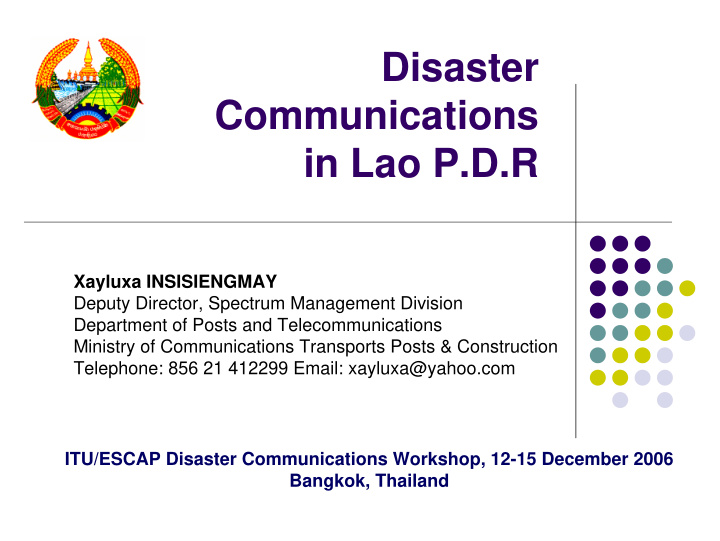



Disaster Communications in Lao P.D.R Xayluxa INSISIENGMAY Deputy Director, Spectrum Management Division Department of Posts and Telecommunications Ministry of Communications Transports Posts & Construction Telephone: 856 21 412299 Email: xayluxa@yahoo.com ITU/ESCAP Disaster Communications Workshop, 12-15 December 2006 Bangkok, Thailand
Outlines: Country profile 1. Disaster threats in a country 2. National agencies dealing with DC/DM 3. Department of Posts & Telecoms 1. Department of Roads 2. Department of Meteorology and Hydrology 3. National Disaster Management Office 4. Strategies and Initiatives 4. Challenges and areas of assistance required 5.
1. Country Profile • Name of a Country: Lao People’s Democratic Republic • Population: 5,6 millions (2005) (80% live in rural areas) • Area: 236,800 Km2 • Provinces: 17 • Districts: 142 • Rivers & Streams: 18 (including Mekong river) • GDP: US$ 350 (2005) • Tele-density: 18 per 100 inhabitants (2006)
2. Disaster Threats in a country � Main Disasters: � Floods � Mountainous flash flood � Soil erosion
3. National Agencies dealing with DC/DM Department of Posts & Telecoms, MCTPC 1. – Radio Spectrum Management Division Department of Roads, MCTPC - Waterway 2. Administration Division (WAD) Department of Meteorology & Hydrology – 3. Ministry of Agriculture & Forestry National Disaster Management Office 4. (NDMO) – Ministry of Labour & Social Welfare
3.1 Department of Posts & Telecommunications � Responsible for frequency allocations and frequency assignments to radio communication services including PPDR � Key regulatory framework that has been taken into consideration: National Table of Frequency allocations and assignments � Resolution 646 (WRC-03) - PPDR � ITU-R M.1637 (2003) – Global cross-border circulation of � radiocommunication equipment in emergency & disaster relief situations Frequency harmonization for PPDR (406.1-430 MHz, 440-470 MHz, � 806-824/851-869 MHz, 4940-4990 MHz, 5850-5925 MHz) � A frequency band 4940 – 4990 MHz has been endorsed for PPDR applications
3.1.1 Telecommunications infrastructure and Statistics
3.1.2 Telecommunications infrastructure & Statistics (Cont’d) � Fibre optic networks are expanding and covering 15 provinces � Mobile Telephony has been increasing rapidly � More than 90% of districts have access to telecommunication services nation-wide � Telephone density reaches 18% in 2006
3.2. Waterway Administration Division (WAD) � There are 53 hydrologic and 18 rainfall stations under WAD’s responsibility � WAD collects data from provinces by radio- transceiver, telephone, fax, email, telemetry system � WAD disseminates data to DMH and MRC by means of telephone, fax, email, telemetry system � The flood forecasts of the Mekong mainstream station are updated every day during flood season (http://ffw.mrcmekong.org/overview.htm) � WAD distributes forecast data updated by MRC to provincial offices and relevant agencies
3.3. Department of Meteorology and Hydrology (DMH) � 53 Meteorological networks and stations nation-wide � 33 stations are using transceiver radio VHF SSB � 20 stations are PSTN (fax and telephone) � A C-band Doppler weather radar and HRIT satellite receiving equipment via MTSAT located in Vientiane � Dedicated telephone line is used to connect to Global Telecom Systems for regional and global data exchange
3.3.1 Organization chart Provincial Hydro-Meteo Station Water way Hydro Station LNMC MRC Dept. of Meteorology and Hydrology (DMH) Prime Minister’s Provincial Mass Media Provincial MAF Office Hydro-Meteo TV, Radio, News TV/Radio Stations MIC NDMO Provincial Ministries Agriculture Others And Forestry concerned services Electricity Hydro-Power Source: DMH
3.4. National Disaster Management Office (NDMO) � NDMO is playing a vital role in DM � 91 offices are located at district level � 100 representatives are present at village level � Youth, Woman and Trade Unions are actively participating in DM
3.4.1 Organization Chart Vice Prime Minister National Disaster Management Committee Ministry Focal Points (MFP) National Disaster Management Office (NDMO) Provincial Focal Provincial Disaster Point in Management Committee Unit (PFPU) (PDMC) Ministry Focal Point Unit (FPU) District Focal District Disaster Point in Unit Management (DFPU) Committee (DDMC) Belong line Coordination Village Disaster Protection line Unit (VDPU) Source: NDMO
4. Strategies and initiatives � Work progress � The Government has recognized the importance of DM � DPT is supporting and approving APT & ITU recommendations regarding PPDR discussing in various regional and international forum and conferences subject to national policy and in accordance with NTFA � 2 decrees have been approved and signed by PM and Minister of Labour and Social Welfare
4.1 Strategies and initiatives (Cont’d) � There is a national strategic plan for DM in Lao P.D.R from 2003 – 2020 � This plan is an integration part of national policy on economy growth and poverty eradication and graduation from LDC status by the year 2020 � Two provinces namely Savannakhet and Khammouan have already set and implemented their own strategies according to the national strategic plan for DM � Most meteorological stations are at district level � Most NDMO representatives are at district and village levels
5. Challenges and areas of assistance needed � Challenges: � No clear policy on the use of frequency bands identified for PPDR in ITU-R M. 1637 � No law and regulation on PPDR, especially with respect to considering a) and b) of Resolution 646 (WRC-03) � Harmonization of frequency bands for PPDR � Lack of skilled personnel in representative offices at district and village levels � Lack of radio and telecommunications equipment e.g. computer, Internet ect. � Budget constraints to implement the government’s policy and guidelines
5.1 Challenges and areas of assistance needed (Cont’d) � Assistance: � Consultancy on PPDR issues � Capacity-building at different levels � Regulatory frameworks for PPDR � Budget assistance to raise public awareness and other activities necessary � Modern early warning systems/equipment
Thank you!
Recommend
More recommend